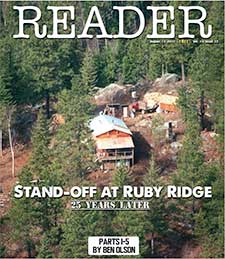What we can’t do to address our housing crisis
By Cate Huisman
Reader Contributor
It’s a little painful to see our fields and empty lots filling up with housing, but this is good, because we have a shortage of housing — right? The problem is, no one in town can afford the houses that are being built. “The market” is working, but not for Sandpoint residents and workers — it’s working for retirees and second-home buyers and investors and speculators who can pay the prices our current market demands — not for people whose income is based on their work in our community
Why can’t we build the housing we need? Why isn’t Planning and Zoning doing something? Where is the City Council? What happened to the mayor’s workforce housing task force? Isn’t there some way our local government institutions can stop this?
As it turns out, no. Local governments in Idaho are severely constrained in the limits they can put on land development. Idaho is a “Dillon’s Rule” state, which means essentially that local governments can’t enact limits on development that aren’t already allowed for in state law.
When we look to how other communities have dealt with this problem, we see a variety of options that aren’t open to us.
Durango, Colo., requires developers to build a certain amount of workforce housing along with their more expensive housing. Idaho state law makes no allowance for this, so we can’t create such a requirement as a local community.
South Lake Tahoe, Calif., has prohibited all use of properties as short-term rentals except in one small, defined area. This makes more properties available for long-term rental or purchase by workers. But, in general, we can’t do that in Idaho — although Sandpoint has managed to put some limitations on STRs.
Vancouver, B.C., and other communities charge an “empty homes” tax on dwellings that are unoccupied for some significant portion of the year. The proceeds are used to fund programs to help working people buy or rent homes. This seems like a good idea for us, as some estimates indicate that up to 40% of our houses are second homes. But this is not provided for within Idaho Code. The Idaho Legislature would have to change something to allow this.
Could we streamline permitting for workforce housing? Maybe bump affordable developments to the front of the line for getting permits or lower the cost of permits for them? Probably not. There are issues of fairness and favoritism.
How about putting a moratorium on building any more houses, until we’ve figured out how we can get the homes we need built, instead of the overpriced ones that only outsiders can afford? In a time when there is a shortage of homes, deciding to build fewer is a dubious enterprise. Besides, here in Idaho, interfering so significantly with private business would require that we demonstrate that public infrastructure is in danger of imminent failure. We have to hope that’s not the case.
To be fair, the city has changed some zoning over the past 15 years in ways that are helping us make better use of our available land. Multi-family houses are allowed in more areas, accessory dwelling units — “granny flats” — have been specifically allowed in most areas and mixed uses have been encouraged, allowing for housing in second and third stories over storefronts. Planned unit developments and “cottage housing” allow for variations to setbacks and other regulations that also enable more effective use of land.
These are all options for landowners and developers. But we can’t insist that developers use them.
“The way the Idaho Constitution and Idaho Code are written, [local] government can’t fix the housing crisis,” according to Fonda Jovick, attorney for the city of Sandpoint. “We don’t have statutory authority.”
So are we doomed to be surrounded by whatever houses builders want to build, with no regard for whether people who work here can live in them? No, but it will be up to us — individuals and organizations, not-for-profits, non-governmental agencies and land trusts — to provide the impetus and make the investments we need.
Cate Huisman served for 13 years on the city of Sandpoint’s Planning and Zoning Commission.










 Coming up this week! Don’t miss Live Music, the Summer Sampler, the Art Party, Monarch Grind, the Sandpoint Renaissance Faire, and more! See the full list of events in the
Coming up this week! Don’t miss Live Music, the Summer Sampler, the Art Party, Monarch Grind, the Sandpoint Renaissance Faire, and more! See the full list of events in the 